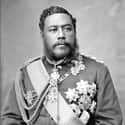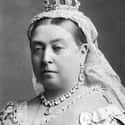-
(#1) A Hawaiian King Was The First To Travel The Globe
David Kalakaua (1836-1891) reigned as King of Hawaii from 1874 to 1891. According to the Hawai'i Digital Newspaper Project, he embarked on his 1881 world tour "to study immigration, develop diplomatic relations with other countries, and observe how rulers led their countries."
This was the first time a monarch had made such a journey, and the year-long trip included visits to San Francisco, Japan, China, India, Egypt, Italy, the German Empire, and England, among many other nations.
-
(#2) Elizabeth I of England
- Notable Figure
In the 1590s, a chamberlain of Queen Elizabeth I (1533-1603 AD) brought her a stocking that had been woven not by a person but a machine. The machine was invented by William Lee, an early herald of the Industrial Revolution. However, the queen chose not to invest.
Elizabeth allegedly said, "I have too much love for my poor people who obtain their bread by the employment of knitting to give my money to forward an invention that will tend to their ruin by depriving them of employment and thus making them beggars."
-
(#3) Louis XIV of France
- Notable Figure
In 1685, the long-reigning King Louis XIV (1638-1715 AD) was suffering from a painful anal fistula. The pain was so great the Louis was willing to undergo experimental surgery to relieve the fistula - though at possible risk of his life.
French citizens were afraid for Louis's health, and one headmistress composed an inspiring song for her students to sing, entitled "God Save the King."
As Medium explains, "About 30 years later... [George Frideric Handel] was passing through Paris when he heard the enchanting tune. Handel enjoyed it so much that when he returned to the UK (where he was living at the time) he had it translated (really, plagiarized) into English and repurposed for the Queen."
-
(#4) Justinian II Replaced His Mutilated Nose With A Gold One To Regain The Throne
According to Byzantine tradition, emperors had to be free of physical imperfections. This was why Leontios cut off the nose of Emperor Justinian II (c. 668-711 AD) when he usurped the throne in 695 AD. Leontios then exiled Justinian from the kingdom and had his supporters burned alive.
Justinian II was not a particularly popular emperor, but Leontios didn't fare much better. He himself was usurped in three years - and had his nose cut off as well. Justinian regained the throne in 705, this time wearing a golden nose prosthetic.
Unfortunately, the new nose did nothing to improve Justinian's personality or style of leadership. He was removed again from the throne - and this time executed - in 711 AD.
-
(#5) Napoleon Bonaparte's Brother Once Lived In New Jersey
When he crowned himself emperor, Napoleon Bonaparte invested himself with the power to make anyone king of anywhere he pleased. He selected his older brother Joseph to become the King of Naples from 1806-1808, and then King of Spain from 1808-1813.
Following Napoleon's final defeat in 1815, Joseph briefly settled in the United States. In 1816, he took up residence at Point Breeze in Bordentown, NJ. After his home burned down in 1820, he built a grand mansion to replace it. It was the “second-finest house in America” (the first being the White House), according to author Patricia Tyson Stroud.
Joseph left New Jersey in 1839 and returned to Europe, where he passed in 1844.
-
(#6) Tsar Nicholas II Had A Tattoo Of A Dragon On His Forearm
Nicholas II (1868-1918) received his tattoo in 1891 while visiting Japan. According to Town & Country, the large design required seven hours to complete.
And Nicholas was not the only royal to get inked. King George V, King Edward VII, Catherine the Great, and Peter the Great are all believed to have been tattooed at some point.
-
(#7) Henry VIII of England
- Notable Figure
Apparently, this wasn't done as a stunt but to relieve the horrendously poor sanitation of Henry VIII's Hampton Court. Yes, Henry's courtiers had their own private places to do their business, but the servants? Not so much.
The "Great House of Easement" was a two-level toilet "block" that could seat 28 at a time, had no stalls, no walls, "and greatly resembled the other public toilets in England, which were basically glorified benches with holes cut through them."
This communal toilet emptied into a tank that had to be regularly cleaned out by boys known as "Gong Scourers." In at least one instance, the tank was filled till it was "head-high."
-
(#8) Queen Victoria
- Notable Figure
There's a reason Queen Victoria (1819-1901) is known as the "Grandmother of Europe." Her nine children were wed to various European royals, as were many of her 42 grandchildren. To this day, the monarchs of a handful of countries are counted among her descendants.
Victoria's last surviving grandchild was Princess Alice, the Countess of Athlone and the great-aunt of Queen Elizabeth II. Alice lived to the age of 97 and passed in her sleep in 1981.
-
(#9) Before It Took His Life, The Guillotine Was Modified At The Suggestion Of Louis XVI Of France
Though Dr. Joseph-Ignace Guillotin was personally opposed to executing criminals, he designed the guillotine as a more humane method of capital punishment. This would be less prone to human error than a person wielding a sword or axe.
Allegedly, King Louis XVI (1764-1793) offered some input into the machine as it was being developed in 1791. History Collection claims Louis "fancied himself a bit of a tinkerer, and rather than the crescent-shaped blade they were using, the king suggested an angled one instead."
Two years later, Louis would meet his end on the point of the same machine he helped design.
-
(#10) King Louis IX Is The Only French Monarch To Be Recognized As A Saint By The Catholic Church
Britannica names King Louis IX (1214-1270 AD) "the most popular of the Capetian monarchs." Renowned for his piety, he led the Seventh Crusade (1248-1250) and also perished on a subsequent crusade.
Britannica goes on to state that crowds in "Italy, the Alps, Lyon, and Cluny" all knelt as the procession carrying Louis's remains returned to France. The monarch was considered a saint for decades before Pope Boniface VIII officially canonized him in 1297. He is the only French king to be recognized as a saint.
-
(#11) In 1830, Marie Thérèse Was Queen of France For About 20 Minutes
Royal successions can be immensely complicated, even during relatively peaceful eras. But during the French Revolution? Forget about it.
Marie-Thérèse Charlotte (1778-1851 AD) was the oldest child of Louis XVI and Marie-Antoinette. Her parents were executed during the French Revolution, which gave way to the First Republic in 1792, which was then overthrown by Napoleon Bonaparte in 1799, who was exiled in 1814 - and then again in 1815.
Marie's uncle became Louis XVIII during the Bourbon Restoration, which started in 1814, but was interrupted for 100 days when Napoleon returned. After the emperor was exiled a second time, the Bourbons were reestablished in 1815. In 1824, Louis was succeeded by Charles X, Marie's father-in-law. Charles abdicated in 1830, which technically made his son, Louis Antoine, the new King of France - and Marie the queen - but Louis also was forced to abdicate in favor of his nephew. Thus, Louis and Marie were the French monarchy for all of 20 minutes.
-
(#12) William the Conqueror
- Notable Figure
William the Conqueror (c. 1028-1087 AD) was the first Norman King of England, and an iron-fisted ruler. Unfortunately, his kingly diet caused his weight to increase in his later years - to a dangerous degree, if some tales are believed.
One account of his passing claims that his gut was impaled by the pommel of his saddle, causing his organs to rupture. After he perished, he was supposed to be placed into a stone sarcophagus, but his bloated corpse was too large for the vessel.
According to the Benedictine monk Orderic Vitalis, when William was forced inside, “[his] swollen bowels burst, and an intolerable stench assailed the nostrils of the by-standers and the whole crowd.”
-
(#13) King Tut
- Video Game
A number of fascinating items have been discovered in the tomb of King Tutankhamun (c. 1342-325 BC), including an ornate dagger forged from a meteorite.
The iron blade sports an engraved gold handle that terminates in a crystal knob, and is paired with a golden sheathe. Iron was rare in Egypt during Tut's reign, and archaeologists generally agree that it was produced from what Ancient Egyptians called "iron from the sky."
-
(#14) The Romanovs' Remains Were Found In 1979, But Politics Prevented Them From Being Revealed Until Years Later
Following the Communist revolution in Russia, the Romanov family was executed in July 1918. However, what became of their remains was kept secret for decades.
Geologist Alexander Avdonin began following rumors of the Romanovs' final resting place in 1970. Working with the son of a member of the Bolshevik secret police, he exhumed the bodies in 1979 near a mansion in Yekaterinburg, Russia - where the family had been imprisoned.
The Soviet Union's distaste for the Romanovs led the two to rebury the bones and wait until more time had passed. The approached the government in 1988, and the official investigation was finally carried out in '91, after the Soviet Union had collapsed.
-
(#15) Cleopatra
- Notable Figure
Though often depicted in media as a scheming seductress, Cleopatra VII (69-10 or 12 BC) was an ambitious, intelligent ruler who went toe to toe with the most powerful empire in her era.
The queen spoke numerous languages, and was the first of Egypt's Greek rulers to actually learn Egyptian. She is even believed to have written books on herbs and cosmetology, though these are lost to history.
-
(#16) Francis I of France
- Notable Figure
At a peaceful summit between England and France known as the Field of the Cloth of Gold, King Francis I (1494-1547 AD) and King Henry VIII (1491-1547) were supposed to be getting along and fight only "as brothers-in-arms." Henry, however, couldn't resist showing off.
As scholar Karen Watts explains, "On one such day there was wrestling and archery. Henry had great success with the bow, while Francis took little or no part in the archery. Afterwards, Henry, rather surprisingly, challenged Francis himself to a wrestling match, but he was quickly thrown by the French king and suffered a subsequent loss of face."
That was in 1520. In the ensuing years, English and French forces would go head to head in several military conflicts.
-
(#17) Marie Antoinette
- Noble person
Many young people grow up playing make believe that they're princes or princesses, but what do you pretend to be if you're an actual princess? In the case of Marie Antoinette (1755-1793 AD), you ask your servants to build you a quaint little cottage on the grounds of Versailles where you can live the "simple" life.
According to the Vintage News, "[Marie] brought her idyllic, picturesque village to life by stocking the barn with animals, and bringing in 'simple' people, such as milkmaids and herdsmen, to act like residents of the Hamlet. Marie Antoinette would stroll around her perfect world in simple shepherdess garb with her children, part of an idealized Nature."
You can still visit the queen's hamlet today.
-
(#18) Mary, Queen of Scots
- Film (1971)
The Catholic Mary Stuart (AKA Mary, Queen of Scots) reigned from 1542 to 1567 during a tumultuous era in England when Catholics and Protestants were at odds. Eventually supplanted by her Protestant cousin Elizabeth I, she was held in custody for many years until Elizabeth decided Mary posed too great a threat (Mary's failed attempt to assasinate Elizabeth clinched that decision).
Unfortunately for Mary, her 1587 beheading went about as badly as such an act can go. As the New Zealand Herald described it, "her execution was absolutely horrendous even by 16th century standards." It took three attempts before the executioner successfully parted Mary's head from her body. Apparently, Mary's dog was with her till the end, and would not leave her side.
New Random Displays Display All By Ranking
About This Tool
Our data comes from Ranker, If you want to participate in the ranking of items displayed on this page, please click here.



























